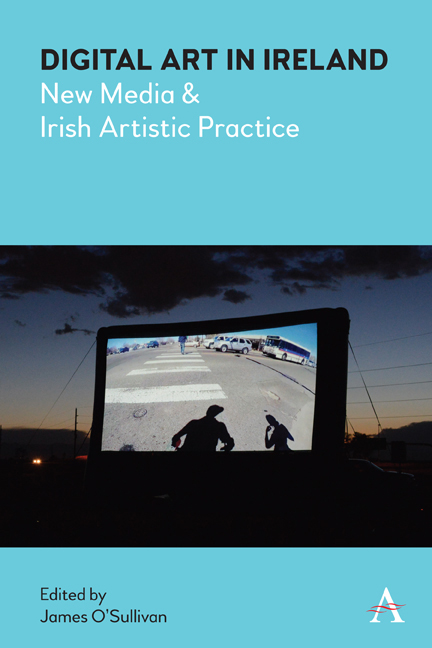Book contents
- Frontmatter
- Dedication
- Contents
- List of Illustrations
- Acknowledgements
- Notes on Contributors
- Chapter 1 Introduction: Digital Art in Ireland
- Chapter 2 Strange Mothers: The Maternal and Contemporary Media Art in Ireland
- Chapter 3 Between Aesthetics and Institutions: Irish Electronic Poetry
- Chapter 4 ‘to shine upon the original all the more fully’: Contemporary New Media Adaptations of James Joyce
- Chapter 5 Art in the Data-City: Critical Data Art in the Age of Surveillance Capitalism
- Chapter 6 Experimental Arcade Video Games as Self-Reflexive Media Art
- Chapter 7 Folding, Unfolding, Refolding Sound Claire Fitch
- Chapter 8 Treacherous Images and Animal Gazes: Ailbhe Ní Bhriain's Reports to an Academy, 2015
- Chapter 9 Pressing Send: Distribution and Curation in Irish New Media Art
- Index
Chapter 9 - Pressing Send: Distribution and Curation in Irish New Media Art
Published online by Cambridge University Press: 23 February 2022
- Frontmatter
- Dedication
- Contents
- List of Illustrations
- Acknowledgements
- Notes on Contributors
- Chapter 1 Introduction: Digital Art in Ireland
- Chapter 2 Strange Mothers: The Maternal and Contemporary Media Art in Ireland
- Chapter 3 Between Aesthetics and Institutions: Irish Electronic Poetry
- Chapter 4 ‘to shine upon the original all the more fully’: Contemporary New Media Adaptations of James Joyce
- Chapter 5 Art in the Data-City: Critical Data Art in the Age of Surveillance Capitalism
- Chapter 6 Experimental Arcade Video Games as Self-Reflexive Media Art
- Chapter 7 Folding, Unfolding, Refolding Sound Claire Fitch
- Chapter 8 Treacherous Images and Animal Gazes: Ailbhe Ní Bhriain's Reports to an Academy, 2015
- Chapter 9 Pressing Send: Distribution and Curation in Irish New Media Art
- Index
Summary
The curation of new media art often stumbles over issues of display, presentation, site and context: where and how best to show artworks that are nomadic, ephemeral, transient or immaterial, and whether such works are even suitable for exhibition within the confines of a gallery or museum space. Is an online work of Net art (or, alternatively, net.art), a video made for YouTube, or a sound art piece uploaded to SoundCloud, better served by virtue of its placement in a physical exhibition space? Does this transference not simply negate or contradict the very qualities that are inherent to new media art? And, if this is the case, what options and responsibilities do curators bear in the selection, mediation and display of such artworks? As Beryl Graham and Sarah Cook point out, in relation to online artworks, ‘Net art demands the context of the Internet and the browsable World Wide Web, and yet curatorial approaches on how to present it have varied hugely as curators come to grips with what the Internet is and how deeply embedded it is in the work of art they are attempting to show’ (Graham and Cook 2010, 70). These attempts have included, among others, the placement of working computers within the gallery space, bespoke interactive displays and installations, so-called media lounges, screen-based presentations of moving images, virtual and augmented reality (generally accessible via the viewer's own smartphone), and 2-or 3-dimensional object-based representations that evoke, relate to or depict new media themes (as seen in much post-internet art). Such decisions are not only present in new media art but have precedence in precursor movements like conceptual art and performance art, with the medium and the means of display inextricably affecting one another: ‘Changes in the curatorship of art involved not only the detached application of new techniques of distribution and display but also an influence on, or even a determination of, the means of presentation, which became an inseparable component of the work of art itself ‘ (O’Neill 2012, 21).
This essay draws on a selection of artworks by Irish new media artists, which I have curated in various contexts over the past 10 years, primarily in my role as senior curator at the Glucksman, a contemporary art museum situated within University College Cork.
- Type
- Chapter
- Information
- Digital Art in IrelandNew Media and Irish Artistic Practice, pp. 135 - 144Publisher: Anthem PressPrint publication year: 2021



